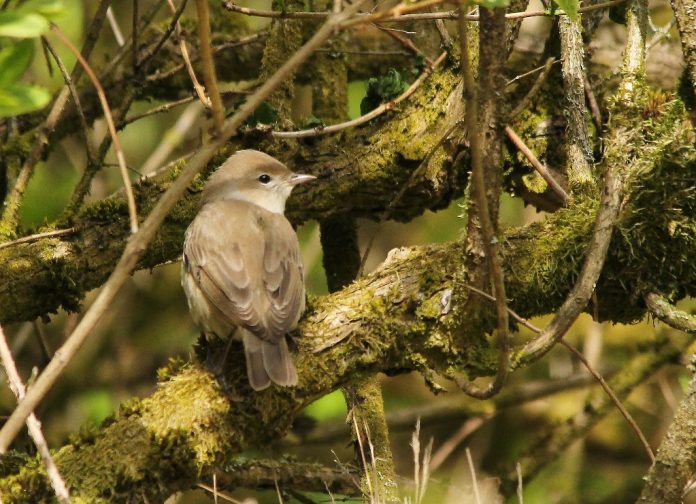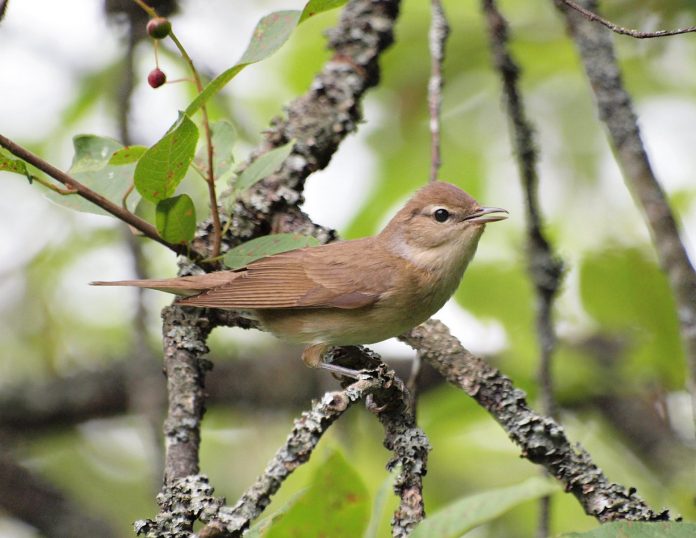The Garden Warbler (Sylvia borin) is a medium-sized bird of about 14 cm in length. The bird is a relatively plump, stout-billed, stout-legged, almost featureless mouse-brown warbler, with outstanding dark eyes and a rather ‘gentle’ facial expression; unlike most Sylvia, it lacks white outer tail feathers. There is little to look out for in plumage other than the pale tips to the tertials (and primaries) and a grayish tinge on the sides of the neck, so this is habitually an inexplicably nondescript bird for the less experienced.
Overall grayish-buff coloration (but not shape) is more suggestive of an Acrocephalus or Hippolais warbler than a Sylvia, but the relatively short and stout grey bill (shading pinker-grey towards the base of the lower mandible). However, the lack of distinct supercilium and eye-stripe, square-cornered tail, and short undertail coverts are easy distinctions from the former, whereas Hippolais of akin size have an even more outstanding dark eye. Moreover, it has a longer, more pointed, broadly-based, and extensively pinkish-orange bill, and a flat or peaked (not rounded) crown shape (and Olivaceous may also have pale outer tail feathers).
However, the confusion of the smallest individuals with Booted Warbler is possible, but the latter has whitish outer tail feathers, paler and thinner legs and bill (quite stout and grayish in Garden); Booted often shows dark at the sides of the crown and is more sandy-brown above. First-year Barred Warbler in autumn recalls Garden but is larger and lankier, usually shows some whitish in the outer tail, and has scalloped undertail coverts and whitish edges to wing feathers.
The most frequent confusion is with poorly seen female Blackcap, which is very similar in overall coloration, size, shape, and vocalizations but has a bright rusty-brown crown (latter is not obvious when the bird is viewed from below). Compare also vagrant vireos. A shy warbler of trees and shrubs, preferring to keep well hidden in foliage, usually revealing presence by song, which can be remarkably similar to that of Blackcap.
All the plumages are similar; the plumage is grayer when worn. In autumn, first-years are in wholly fresh plumage and are tinged slightly more olive and buff overall, whereas adults have tail and flight feathers slightly worn and are more grayish-olive, especially on flanks. Garden Warbler call is a sharp, rich, often-repeated ‘chek’, not quite as strident as that of Blackcap (but more regularly repeated). Garden Warbler’s song is rich, sweet, and sustained, extremely alike to and often impossible to differentiate from some song types of Blackcap.
The comprehensive song is much longer, quicker, ‘tighter’, and less varied than that of Blackcap, lacking the sudden changes in pitch towards the end that are so typical of that species. There are two races according to geographical variation. Eastern Woodward (breeds the White Sea eastward) is paler and grayer than the nominate race of most of the European region.
The two forms intergrade across much of Eastern Europe. The garden warbler is a common and widespread bird. (In addition to mapped range, has bred Faeroes.) Broadleaved and mixed woodland with shrubbery, bushy heath-land, riverine woodland, parks, and big gardens; characteristically a bird of more shrubby habitats than Blackcap, but much overlap.
Related Reading: Black-throated Blue Warbler

